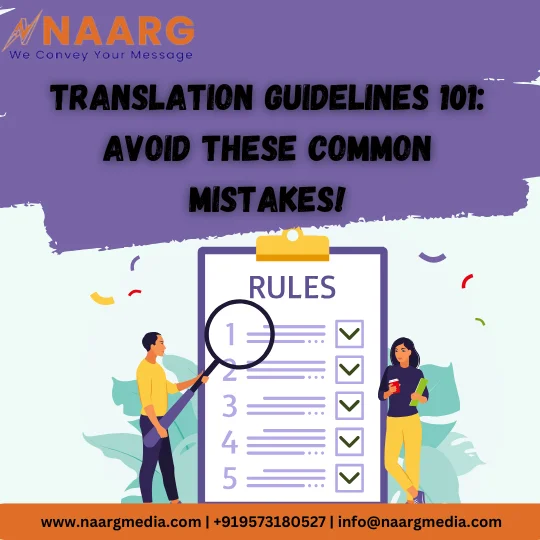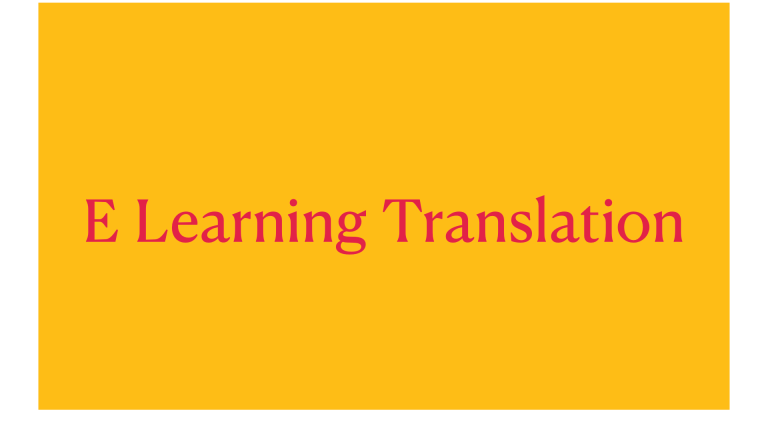You must have heard this phrase before, ‘lost in translation.’ Well, it’s not just a phrase; rather, it is a potential mistake or pitfall that can cost you heavily. It is quite evident that translation blunders can easily tarnish your brand’s reputation.
If you ever wish to see epic translation fails, just type KFC slogan fails. You will see how KFC butchered its famous slogan, ‘Finger-licking good, to ‘Eat your fingers off.’
To avoid these costly mistakes, read this blog on translation guidelines, where we will equip you with strategies to avoid common mistakes. Let’s get started.

What is Translation?
By definition, translation is the conversion of audio, text, and content from one language to another while also preserving the original intent and meaning. One important thing to note is that not all translations are the same.
Several methods serve distinct purposes, each with their application and approach. The translation process consists of two types of languages, and that is the source language and the target language.
The source language is the language of the original documents while the target language is the language in which the documents need to be translated. So, if you approach language service providers, the first thing you will be asked will be about the source and target languages.
That is what translation is all about.
Types of translation
Now that we know what translation is, let’s look at the types of translation.
1. Technical Translation
Technical translation is simply the process of translating technical documents and is used when you want to market a technical product in a different country.
It can be a tricky translation process as it requires professional translators to accurately convey the original text.
The documentation on technical translation includes product data sheets, product descriptions, user manuals, and documents related to technical personas.
2. Legal Translation
This type of translation involves document conversion from one language to another just to streamline the legal matters and proceedings between two legal parties who speak different languages.
This legal translation can be a complicated translation job as judicial systems differ between countries. A professional legal translator must understand the different elements of the legal system just to ensure that all the criteria are properly met.
3. Book Translation
Book translation is a complex service as it requires thorough knowledge of both the source and target languages. Translating a book is a process that requires detailed work, as it requires keeping the author’s meaning and voice while translating into the target language. Only a professional book translator who knows the importance of originality can provide justice to the author’s work.
4. Medical Translation
Medical translation is a type of translation service that covers many areas in the medical field. Like the translation of pharmaceutical products, product information for medical devices, research findings, and patient medical records.
Medical translation plays a huge role in healthcare and for healthcare providers, as they can easily implement treatments required for patients.
5. Document Translation
This translation service means translating text from one language to another in a document form. The documents involved in document translation can be birth certificates, notices, legal copies, brochures, and many more.
Nowadays, the need for online document translation is increasing exponentially because of the increasing number of non-English speakers.
Key Principles of Quality Translation
Quality translation is the degree to which a translation meets its desired requirements. Now quality translations require more than just translating words from one language to another.
Let’s look at the key principles of quality translation.
1. Accuracy
Your translations should be able to accurately convey the meaning of the original text. Accuracy is the paramount principle for a quality translation.
2. Cultural Awareness
The translated work should be sensitive and culturally aware of the cultural differences between the source and the target languages.
3. Linguistic Consistency
The terminology management of the translation should be consistent and linguistically appropriate.
4. Fitness for Purpose
Translation should meet the desired purpose for which it was created. It should dictate the purpose of the work.
Translation Guidelines 101
1. Understand the Source Text
Read the entire text carefully before translating to grasp context, tone, and intent.
2. Know Your Audience
Adapt language, style, and cultural nuances to suit the target audience.
3. Maintain Accuracy
Stay true to the original meaning while ensuring clarity in the target language.
4. Use Consistent Terminology
Follow industry-specific glossaries and terminology databases for uniformity.
5. Avoid Literal Translations
Focus on conveying meaning naturally rather than word-for-word translation.
6. Respect Cultural Sensitivities
Adapt expressions, idioms, and references to fit the target culture.
7. Follow Grammar and Syntax Rules
Ensure correct sentence structure, punctuation, and grammar in the target language.
Common Mistakes in Translation and How to Avoid Them
1. Mistranslations
Mistranslations often stem from inadequate research or a lack of subject knowledge on the translator’s part. Oversight or failure to consider regional variations can result in critical errors.
For example, translating “tram” instead of “train” could confuse a country where trams are not commonly used. Additionally, translators should be mindful of false friends—words that appear similar in different languages but have different meanings, such as the English word “rope” and the Spanish “ropa” (meaning ‘clothes’).
2. Inconsistent Translation
Maintaining a consistent tone and style is essential in translation. Less experienced translators may struggle with this, leading to shifts in tone, improper use of slang or idioms, and structural inconsistencies.
The tone must align with the original content—for instance, an academic paper should retain a professional and formal voice, while technical documents should avoid informal expressions.
3. Cultural Misinterpretation
Accurate translation goes beyond language; it requires an understanding of cultural context. Every language is shaped by the customs, history, and geography of its speakers.
Words may hold completely different meanings in various cultures. For example, the term “desert” is understood by the Maya as an open field, whereas Palestinians associate it with a dry, sandy landscape. A lack of cultural awareness can lead to misinterpretations and errors in translation.
4. Failure to Localize
Language Ignoring regional language differences can lead to unnatural translations. Using terms or phrases that do not resonate with the target audience can diminish the quality and clarity of the text. Some words have no direct equivalent in other languages. For example, the Japanese word “Yūgen” conveys a deep, almost poetic sense of the universe’s beauty and the melancholy of human existence—yet no single English word can capture its full meaning.
5. Lack of Context
One of the most common translation pitfalls is failing to consider context. Literal translations, whether done manually or through machine translation tools, can lead to errors when words have multiple meanings.
For instance, the word “run” can mean to operate a meeting or to participate in a marathon. Without understanding the intended usage, translators may misinterpret the original message.
6. Misuse of Jargon
Even skilled translators may struggle with specialized industry terminology if they are unfamiliar with the subject matter. Expecting translators to automatically understand corporate jargon, insider terms, or technical acronyms can lead to confusion and misinterpretation.
Overuse of such language without proper clarification can result in inaccurate translations that fail to convey the intended meaning effectively.
Best Practices for High-Quality Translation
High-quality translations are critical for delivering reliable, clear information to the target market. Some of the best practices for high-quality translation are listed below.
1. Hire Professional Translators
For high-quality translations, you need to hire professional translators with first-language proficiency.
Professional translators ensure that the translations go beyond basic accuracy. So, if possible, it is advised to work with professional translators who are also subject matter experts.
2. Create Glossaries for Translators
When you provide a detailed glossary with translators of industry-specific terminology, it ensures that the translation process aligns with your client’s preferences.
This terminology management helps you maintain a unified brand voice across all communications, thus streamlining the process of clarity and accuracy.
3. Build Translation Memory
Having a robust translation management system (TMS) helps you to build a perfect database of previously translated phrases and words.
This database helps in new translations as the system automatically suggests the pre-translated phrases and words through a process called automated translation.
This translation memory database helps to cut down on the translator’s workload and also helps keep the cost of translation lower by preventing retranslation.
These translation guidelines will not only help you avoid costly mistakes but will also help you create high-quality and top-notch translations.
We at Naarg only work with native language linguists around the globe, whether they are in India, London, Los Angeles, Japan, Italy, or more locations, who have expertise in a specific domain.
We follow stringent procedures to ensure our client’s content is translated without losing the essence of the source language.
Contact us today to learn more about our services.

